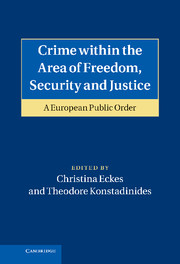Book contents
- Frontmatter
- Contents
- Contributors
- Acknowledgements
- ABBREVIATIONS
- Introduction
- 1 EU criminal justice: beyond Lisbon
- 2 The European Union policy against corruption in the light of international developments
- 3 The EU's anti-money laundering agenda: Built on risks?
- 4 EU anti-money laundering regulation: Multilevel cooperation of public and private actors
- 5 The legal framework of the European Union's counter-terrorist policies: full of good intentions?
- 6 Organised crime: developments and challenges for an enlarged European Union
- 7 The Europeanisation of extradition: how many light years away to mutual confidence?
- 8 The European Evidence Warrant: Mutual Recognition and Mutual (Dis)Trust?
- 9 Law and order and internal security provisions in the Area of Freedom, Security and Justice: before and after Lisbon
- 10 The external dimension of the EU's Area of Freedom, Security and Justice
- Index
- References
Introduction
Published online by Cambridge University Press: 01 June 2011
- Frontmatter
- Contents
- Contributors
- Acknowledgements
- ABBREVIATIONS
- Introduction
- 1 EU criminal justice: beyond Lisbon
- 2 The European Union policy against corruption in the light of international developments
- 3 The EU's anti-money laundering agenda: Built on risks?
- 4 EU anti-money laundering regulation: Multilevel cooperation of public and private actors
- 5 The legal framework of the European Union's counter-terrorist policies: full of good intentions?
- 6 Organised crime: developments and challenges for an enlarged European Union
- 7 The Europeanisation of extradition: how many light years away to mutual confidence?
- 8 The European Evidence Warrant: Mutual Recognition and Mutual (Dis)Trust?
- 9 Law and order and internal security provisions in the Area of Freedom, Security and Justice: before and after Lisbon
- 10 The external dimension of the EU's Area of Freedom, Security and Justice
- Index
- References
Summary
Over the last decade the responsibilities of the European Union (EU) in protecting its citizens from crime, organised or otherwise, have expanded incrementally. Security-led issues have gained particular relevance following the attacks of 11 September 2001, 9 March 2004 and 7 July 2005 and the last two EU enlargements of 2004 and 2007. These events have not only contributed to externalising internal security issues (e.g. through political cooperation with third countries on issues of freedom, security and justice), they have also, most significantly, legitimised pan-European initiatives or, to put it otherwise, they have ‘Europeanised’ internal security issues. This has occurred through the adoption of a wide range of legislative instruments related to law enforcement, cooperation on the prevention and combating of crime, intelligence exchange and public order management.
Until the entering into force of the Treaty of Lisbon much of European criminal law was tucked away in the third pillar of the EU. With the Treaty of Lisbon, the field of judicial cooperation in criminal matters has acquired an identifiable constitutional framework and has become a fully-fledged EU policy. The Treaty introduces the ordinary legislating procedure, involving the European Parliament and allowing the Council to vote by qualified majority in order to establish minimum rules. It also extends the Court's jurisdiction to cover areas of the former third pillar, albeit significantly limited by the transitional provisions (Protocol 36). Finally, the Union's available legislative instruments are strengthened and the principle of mutual recognition formally becomes the backbone of European criminal law.
- Type
- Chapter
- Information
- Crime within the Area of Freedom, Security and JusticeA European Public Order, pp. 1 - 9Publisher: Cambridge University PressPrint publication year: 2011



